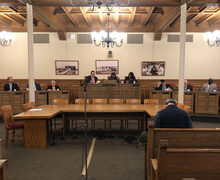McDonell: Trans* model highlights change in fashion, beauty industries
The world of fashion and beauty just became a little more inclusive.
Trans* model Andreja Pejic landed her own campaign with the beauty brand Make Up For Ever and snagged a profile in the May issue of Vogue, making her the first trans* model to be profiled in the iconic magazine.
Pejic, from Melbourne, Australia, was discovered at age 16 while working at McDonald’s. The scout couldn’t tell if she was a boy or a girl — only that she looked like a model. Three years later, Pejic was in Paris, walking in both the men and women’s shows for Jean Paul Gaultier and has recently been cast as an androgynous model by Jeremy Scott, Thom Browne and Marc Jacobs.
Although the inclusivity of the trans* community has improved in the past year, it’s 2015. This should have happened ages ago.
Both the fashion and beauty industries have stuck to a certain ideal of beauty. Only recently have they broadened their definition of what constitutes someone as beautiful. The more we’re able to identify different types of women as beautiful, the more open and accepting the industry as a whole becomes. It’s an important step for these two industries and society as a whole, and it’s exciting to see it happening now.
Pejic, isn’t the first trans* model to snap up a major beauty deal. That prize is given to Lea T, having signed on as the face of Redken in November. Last month, Jazz Jennings, a 14-year-old trans* teen, was named a spokesperson for Clean & Clear.
This trio represents an extremely important shift in the fashion and beauty industries, with trans* individuals now representing makeup, skin care, hair brands and fashion.
Fashion has recently been more accepting of the trans* community. Bruce Weber’s “Brothers, Sisters, Sons & Daughters” campaign for Barneys, in which he photographed 17 different trans* models comes to mind, as does Pejic’s appearance in Jean Paul Gaultier ads and Laverne Cox’s feature in InStyle magazine.
Designers are sending more androgynous looks down the runways and have started using both male and female models for womenswear and menswear, which means they aren’t assigning designs to a specific gender.
The beauty industry is a different story. It’s been stricter than the fashion industry, defaulting to traditional gender and appearance norms. But things are still changing, just at a slower pace.
According to the Vogue article about Pejic, the most frequently cited population of trans* people in America is 700,000, which is most likely a low estimate. Out of this number, 90 percent said that they have dealt with discrimination at work, and almost 20 percent reported being denied a place to live. Forty-one percent have attempted suicide.
Despite making up a tiny percent of the population, the trans* community has grown tremendously in recent years. However, they have had very little representation across any form of media. The only person that comes to mind is Laverne Cox from the hit Netflix show “Orange Is the New Black.”
In the political world, trans* people have had several milestones within the last year. Wellesley College became the latest all-women’s institution to consider any applicant who “lives and identifies” as a woman. Medicare has also dropped its trans* exclusions, and 62 American universities provide hormones and gender-confirmation surgeries for their students, according to the same Vogue article.
In the future, I look forward to seeing fashion and beauty campaigns feature more trans* models and the many different women that are now being encompassed into the socially recognized standard of beauty. Until then, we’ll have to count the progress we have made so far as a major win.
Alexis McDonell is a junior magazine journalism major. Her column appears weekly in Pulp. You can email her at admcdone@syr.edu.
Published on April 26, 2015 at 9:11 pm





